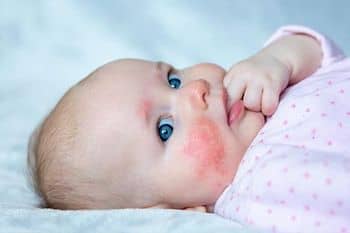02.09.2022
Until recently, it was controversial whether a deficiency of vitamin D in a pregnant mother could cause neurodermatitis in an infant. A British study has now been able to show that supplemental vitamin D3 administration during pregnancy significantly reduces an infant’s risk of developing atopic dermatitis in the first year of life. [1]

In areas with little sun, such as Europe, children under five are particularly susceptible to developing neurodermatitis (atopic dermatitis/eczema). In Germany, about 23% of infants and young children are infected. [2] The typical symptoms of inflammatory skin disease are a red, itchy rash that causes dry, flaky skin.
With the Mavidus Study Group, researchers from the University of Southampton investigated whether additional administration of vitamin D3 in Pregnancy Frequency of atopic eczema (neurodermatitis) in the offspring. For this purpose, the team recruited 703 pregnant women from the Mavidos Study (the Maternal Vitamin D Osteoporosis Study) and distributed them between the fourteenth and seventeenth. Random pregnancy week in two groups:
- The 352 women in the intervention group also received 1,000 IU (25 micrograms) of vitamin D3 per day in tablet form.
- Instead, 351 women in the control group received a placebo (without vitamin D3) daily.
Furthermore, all women were allowed to continue taking up to 400 IU (10 mcg) of vitamin D3 per day. For comparison: The German Society for Nutrition recommends that pregnant women get about 800 international units (20 mcg) of vitamin D per day if they don’t have enough exposure to sunlight. [3].
All participants initially had a serum 25-OH-vitamin D level of 25-100 nmol/L – with values below 30 nmol/L indicating vitamin D deficiency. [4].
Taking prenatal vitamin D can significantly reduce the risk of developing neurodermatitis in the first year of life
As part of the study, women were asked about skin symptoms in their offspring after 12, 24 and 48 months of age and the children were examined. In the intervention group with supplemental vitamin D3, the risk of developing neurodermatitis in the first 12 months of life was 45% lower than that of the control group.
The researchers also found that the mother’s breastfeeding behavior is critical to the protective effect of vitamin D3. The risk of developing neurodermatitis was reduced by 52% in the first 12 months if the mother (intervention group) was at least 1 month after Birth still silent. In mothers who breastfed for less than a month, the risk of developing neurodermatitis was reduced by only 20% – which means that the protective effect of prenatal vitamin D3 is no longer significant. The protective effect was also no longer significant after 24 and 48 months.
Dr. Elhais and her team conclude from their findings that taking adequate vitamin D3 supplements during pregnancy can help prevent childhood neurodermatitis.
Sources:
[1] El-Heis S, D’Angelo S, Curtis EM, Healy E, Moon RJ, Crozier SR, Inskip H, Cooper C, Harvey NC, Godfrey KM. Vitamin D supplementation of prenatal mothers and offspring risk of developing atopic eczema in the first four years of life: evidence from a randomized controlled trial. Br J Dermatol. 2022; DOI: 10.1111 / bjd.21721

